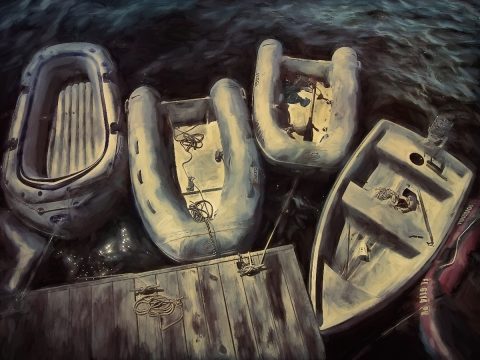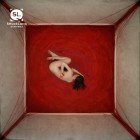This story is very much a commentary on storytelling itself, made very clear when “the girl” enters the page. You write, “There was a girl, too, not a character but an actual person, who really did say, ‘I want to be lost in the heat stink of jungle and surf, to raise the sea as my child, to have it break my heart.’ ” I also found this commentary weaved through the images, which felt like stock cinematic imagery of what you might find in a movie set in South America, but which were also very evocative and rich. And then again, in the beginning, and end when you allude to the idea that this story already exists…that it is not a tale, but rather something like a memory. This was all done so beautifully. What was the statement you wanted to make about storytelling?
Thank you. That’s kind. Regarding statements, I don’t know—my experience has been that such statements are rarely known to a writer at the moment of creation but become clear only afterward upon reflection. Rather than a statement, I believe I was just thinking about how the story was not totally fiction, nor was it non-fiction, but rather some blending of fiction, experiences, faulty memory. What I was going for, I think, was the truth of what this part of my time in Santa Teresa was like and how it felt. Some of the things in the story really happened, some didn’t, most are a blending of that—things that did happen but not quite the way the story presents them. I think my hope was to convey as authentically as possible what it felt like to think about this place and this girl and sometimes to do that authentically you must make intentional use of the inauthentic in your story. I agree with Marquez and Chandler’s point about the absolute necessity to root one’s fiction in actual experiences so that your personal connection to a place or a person will help your reader perceive them as real and therefore connect with the story more deeply than they would otherwise. But I also agree with Lorrie Moore when she says if you’re trying to write things exactly as they happened, then the writing will be dead, and the story will go nowhere. Maybe the statement would be that perhaps good storytelling finds itself somewhere in the middle of those two ideas.
Have you read many South American writers? If so, who? Did their work inspire this piece in any way?
Costa Rica is in Central America, so I’m thinking that’s what you’re asking. I’ve not had the chance to read a lot of longer works by Central American authors, but I can recommend a particularly excellent collection of short fiction by Costa Rican authors. Costa Rica: A Traveler’s Literary Companion compiles a great survey of contemporary Costa Rican fiction. Barbara Ras, a former Georgia Poet of the Year and the current director of Trinity University Press, edited the collection, so the works really do pack a literary punch. “The Girl Who Came From the Moon” is my personal favorite from the collection, but they’re all solid and a great introduction to writers from CR.
 Who is Margriet? I like to imagine she is the girl in the story, but I am probably wrong.
Who is Margriet? I like to imagine she is the girl in the story, but I am probably wrong.
You’re not wrong! Margriet is a good friend of ours from Santa Teresa. She’s just this tall, kind, high-energy, incredibly creative, bad-ass surfer, and likely the coolest mom on the planet. [She’s also created the art for my story, and this second piece as well.] When my wife and I moved to CR for a few months, she was one of the first people to come up and chat and welcome us—just a very positive and inspiring person. She’s also an exceptionally talented painter and a bit of a local celebrity for her art, which is always a big hit with locals and visitors to the area. If you visit her café, there’s a good chance you’ll see her and her lovely daughter, Zaia, covered in paint and producing some brilliant new work on a large canvas. If she’s not there, then she’s likely out on the water killing it on some rather large waves or rocketing over the unpaved roads to Cobano to get art or café supplies.
This piece started primarily as a story about a place, but Margs is so much a part of that place in our heads. I found that this work was really the result of thinking about Santa Teresa and thinking about our friend and her daughter and the lives they’ve had, are having, and will have there. It was sort of beautiful and interesting to think about them in that way and then try and capture the feeling through the play of imagination and language.
I was very impressed with the language in this story. I imagine it took quite some time to get everything perfect. How long did it take you to craft this piece? Were the language choices there from the start or did they come from deliberate decisions during the editing process?
I’m not the editing process type, though a lot of writers I know are. This is probably because I have a short attention span and get bored easily. I pretty much write things in one go, revise a couple of times—maybe shift a line or two around—and then I’m pretty done with it. Either it works, or it doesn’t. I think what I’ve realized is that I write best when I’m feeling something unusual or in a particular mood, and that’s when I try to create and capture something in one go. Once the mood is gone, and I can’t feel the entirety of the story anymore, trying to do any significant changes would be pointless—like continuing to try and have a conversation with the story after it has packed up and left the room. The language choices are there from the beginning because the mood determines the tone and style of the piece.



 The core workshop of SmokeLong Fitness is all in writing, so you can take part from anywhere at anytime. We are excited about creating a supportive, consistent and structured environment for flash writers to work on their craft in a community. We are thrilled and proud to say that our workshop participants have won, placed, or been listed in every major flash competition. Community works.
The core workshop of SmokeLong Fitness is all in writing, so you can take part from anywhere at anytime. We are excited about creating a supportive, consistent and structured environment for flash writers to work on their craft in a community. We are thrilled and proud to say that our workshop participants have won, placed, or been listed in every major flash competition. Community works.